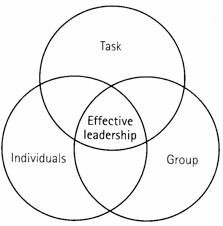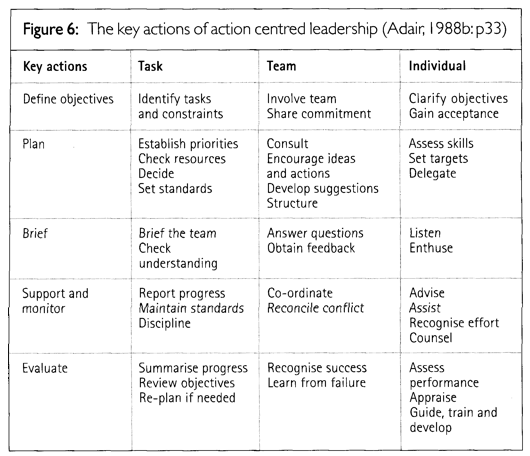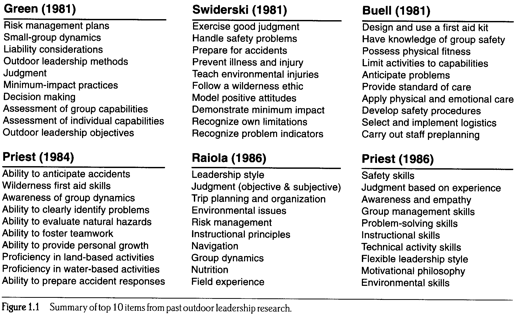A BA Outdoor Leadership year 3 assignment 1, Practice Outdoor Leadership By Eben Farnworth
Introduction
The science of outdoor leadership aims to identify the key factors that make an activity successful or unsuccessful. It is based around the following statement:
The single most important attribute for an effective outdoor leader is the ability to accurately assess the current and potential ability level of a client. (Wilson 2003)
There are lots of different aspects of leadership covered in this report, including action centred learning, leadership styles, communication, risk management, and others.
Clarification
This report assumes that the above statement refers to the generic skill of client ability assessment covering all outdoor work with paying clients. This includes every activity from base jumping to dry stone walling holidays, nature walks, skiing, kayaking, climbing and all other outdoor activities in all outdoor environments.
What is outdoor leadership?
Leadership covers so many aspects and means different things to different people. Some people who have tried to define it have come up with statements like:
Leadership is the capacity to move others toward goals shared with you, with a focus and competency they would not achieve on their own. (Graham 1997: 12)
See appendix 1 to for the questionnaire response that he used to write the above quotation.
The leader's role is to help the party achieve the team's objectives in a safe, enjoyable manner, with minimum impact on the … environment. (Cox and Fulsaas 2003: 461)
A leader helps a person or group of people achieve something they could not achieve on there own. At the same time looking after safety, environmental impacts and enjoyment for the people involved. However as Graham points out:
Leadership is not a science to be picked up in one book or course, but an art to be learned over time. Good leaders sometimes tell people what to do, but leadership is not just giving directions-it's liberating people to do what is needed in the best possible way. (Graham 1997: 9)
Leadership is a skill that takes time to learn and develop, this is especially the case in outdoor environments because of there diversity and ever changing nature.
Criticism of the starting statements
The first and most obvious error in this statement is that it encompasses all outdoor instructors, leaders, teachers and facilitators. For example, a bungee jumping instructor does not need to know his or her client’s ability for a standard jump. They just need to know their weight; their ability to fall can then be predetermined according to the laws of gravity.
The other problem with this statement is that it forsakes all other considerations and decisions that an instructor has to make. It is equally important to judge the environmental conditions and objective risks in an ever changing outdoor world. These can then be related to client ability to make decisions for the situation.
Interpersonal
Action Centred Leadership
Barnes (2002: 18-19) discussed Adair’s model of action centred leadership showing that it demonstrated the three main areas which every leader has to consider, task, group and individuals. Truly effective leadership is the point where the leader is meeting the needs of the group, the individual requirements and staying focussed on the task. See the model below:

See also in appendix 1, a table displaying the key actions of action centred leadership.
This implies that action centred leadership solves all the problems in a simple way; as long as the leader is constantly making sure that the group is catered for, the task is getting completed and the individuals are being looked after properly, every thing will go well. Outdoor leadership is more complicated than that; in an outdoor environment the leader’s role is often always changing, moving from assessing the environment and risk, to the client’s ability or giving encouragement, teaching skills, using remote supervision and many more. Hersey and Blanchard (1982) suggested that as well as the three elements of action centred leadership a leader needs to look after and monitor the working relationships of the group members and be able to adapt and change leadership styles to suit different situations.
Why do we lead in the outdoors?
A lot of leadership text books discussed the importance of outdoor leaders knowing why they lead. For example Hampton (2002: 85) and Langmuir (1998: 318) both discuss in the introduction of their leadership chapters the importance of each individual leader finding out why they wish to coach, or why they are coaching.
Why do you coach or lead others? Are you trying to replicate your previous experiences for them? Why sacrifice personal paddling time for other people? Is it money, ego, or have you been drawn into a coaching situation almost by accident. (Hampton 2002: 85)
Langmuir said similar for mountain leaders; both are making the point that a leader’s motivation to lead, coach and facilitate in the outdoors will determine the types of outcome they will achieve. “The point here is that why we do certain things will often define how we do things.” Hampton (2002: 86) A good leader will be leading for the right reasons as Graham highlights below:
The most important aspect of leadership is having a reason for leading beyond investing in your own ego. It takes passion and genuine intention to be a good leader. (Graham 1997:16)
So having the right reason for leading can make people better leaders, see appendix 2 for Daumal and Analogue's poetic suggestion on why people should be taken into the mountains. Graham backs up the augment for knowing why leaders lead:
What you believe about leadership--your attitudes--will greatly influence the results you get as a leader. They'll not guarantee success--but they'll definitely improve your odds. (Graham 1997:15)
Technical
For outdoor leader’s technical competency is very important:
"If, as an outdoor leader, you are able to perform at a proficiency higher than that of the group members, you will probably have a much easier time in maintaining group control during these activities, giving you a greater margin of safety by providing a cushion of competence." (Priest and Gass 1997: 3)
Priest and Gass regard technical skills as being the most important starting point for outdoor leaders. They believe that for someone to become an effective outdoor leader they must first have a good knowledge base for the activity and personal competence. This can help people develop belief in their ability and build their confidents as a leader. They will be able to operate safely because of their technical capability, which is the fundamental job of an outdoor leader. And in relation to the starting statement to assess client ability a leader must first be able to assess the activity to compare with what the clients are capable of achieving.
Eben’s thoughts and experiences 2005
Rational for this section
This section is written is the first person as it is about the writer; this aids clarity for the reader and makes it easier to read.
As a practitioner of outdoor education for the past four seasons I have found that being flexible in my work and quickly developing rapport with groups are my most useful soft skills. Underpinning this is communication and technical skills. For me technical skills are easier to learn and perfect; they are more tangible and measurable than soft skills.
An instructor may be able to communicate very effectively with one group but another group from a slightly different culture may be much more challenging. This is where experience comes into its own, as a leader with more experience can generally build rapport quicker with groups they have not worked with before.
Here is a list of important generic attributes of outdoor leaders created by the righter:
- Assessing risk
- Developing rapport
- Communication skills
- Interpersonal skills
- Teaching skills
- Technical skills (Paddling or climbing ability and competence)
- Environmental awareness
- Working under pressure
- The ability to stay focussed to the task when cold tired and hungry
- Meta skills
- Knowing one’s own limitations
- Risk Management
- Academic theories
See appendix 1 to compare the writers list with the one made by Graham (1997) and appendix 3 to compare with priest’s and Gasses study off outdoor leadership qualities.
British Mountaineering Council (BMC) and Mountain Leader Training Board England (MLTE)
Langmuir (1998: 317) explains the importance of outdoor leaders knowing their subject so well that they can instigate all the components simultaneously “…similar to the way in which tapestry threads interweave to form a pattern or picture”. Each thread and pattern has a relationship with the whole object. He said that the factors and their relationships must be totally understood by the leader so leadership decisions can “… occur naturally and spontaneously” Langmuir (1998: 317)
“There is no such thing as a bad group only poor leadership” (Mick Jenings 2002 M.I.C.)
The management of risk
Risk management is one of the most important skills for an effective outdoor leader because “Being a leader also means taking on risk and responsibility” (Graham 1997:16). "Successful risk management requires combining technical, leadership and people skills on the part of the instructor in an on-going process of decision making”. (Peter 2004: 207) Outdoor activities are dangerous; outdoor leaders have to constantly monitor and evaluate risk in an ever changing environment. This is called an ‘ongoing risk assessment’; the leader can assess the risk and compare it to the client ability to make stable judgments of the situation. It is therefore vital that the leader has the correct amount of experience, knowledge and the skills for the task. If the leader does not then they will not be able to make informed, safe and suitable decisions. Langmuir (1998: 318) discuses the balancing act of risk management in the outdoors, between what is safe and perhaps dull for the group and what is more dangerous and potentially exiting and stimulating. the British Canoe Union (BCU) use this formula in the Canoe and Kayak Hand Book “Technique + experience + being dynamic = skilful judgements” Hampton (2002: 86) good judgement + successful risk management = keeping clients safe, which for fills the many criteria for an effective outdoor leader.
What is the most important attribute for effective outdoor leadership?
Priest and Gass identify the following 12 points as being the most important attributes for an effective outdoor leader:
- Technical skills
- Safety skills
- Environmental skills
- Organizational skills
- Instructional skills
- Facilitation skills
- Flexible leadership style
- Experience-based judgment
- Problem-solving skills
- Decision-making skills
- Effective communication
- Professional ethics
(Priest and Gass 1997: 2 - 4)
See appendix 3 for a collection of research answers on what makes an effective outdoor leader from around the world compiled by Priest and Gass.
They are in order of priority with technical skills at the top. This is in contrast with Barnes who says communication and Wilson who says assessing client’s current and potential ability are the most important attributes. But overall the righter agrees with Barnes that communication is the starting point for all leadership activities. There are so many skills required by outdoor leaders that its not possible to cover them all in this report. At the root of all leadership activity is communication skills. Without these a leader is power less, however good there technical skills are:
Leadership, to a large extent revolves around communication; it is the basic skill or tool around which all other facets of a leader stem. Barnes (2002:24)
Communication comes in many forms, all of which an effective leader should make use of. For example:
-
One way and two way communication
-
One to one and one too many
-
Verbal and non verbal communication
One and two way communication when a leader gives an instruction they should always look for a response. It could be a spoken response for example Leader – ‘is that carabineer dun up’. Client – ‘I don’t know I think so’. That example is of verbal one to one communication. However when a leader is speaking to a group (one too many) they will not always get verbal responses from all there clients. This is when the leader needs to look for the non verbal sine’s which may give him/her clues to how the group is feeling; for example hot, cold, tired, scared or content. The leaders non verbal communication is also very important; the sine’s that he/she is giving out need as much monitoring as what is said.
Effective communication allows a leader to:
- Keep groups safe - provided the instructions are correct
- Develop rapport
- Keep a group interested
- Teach skills
- Set bounders
- Be effective.
Communication is the back bone of interpersonal skills, which are needed to influence people and as Priest and Gass say below, the ability to influence people, is the ability to lead:
Leadership is a process of influence. In most informal group settings, people who become group leaders influence other group members to create, identify, work toward, achieve, and share mutually acceptable goals. (Priest and Gass 1997: 3)
Conclusion
This assignment identifies some of the many skills, considerations and values concerning outdoor leadership. It finds that communication is the fundamental skill for outdoor leaders to build all the others around. However other than the ability to communicate there is no ‘magic key’ to leadership, no single skill or ability that is important above all else. This is because outdoor leadership is so varied, every single group is different from each other and every individual is unique within all groups. The outdoors and the activities which leaders guide their groups through are as diverse as the groups themselves. This multitude of diversity in groups and environments should be promoted and celebrated, not put into boxes, refined or sanitised for the ease of outdoor practitioners.
It is acknowledged that assessing client ability is essential but is not always of the utmost importance in all outdoor adventure situations. To assess client ability a leader must first have the technical skills for the activity to relate to the clients ability, and the communication skills to teach and lead safely and effectively.
So to conclude - The two most important skills for an outdoor leader to have is – Communication and Technical competence.
Bibliography
Cox S.M., and Fulsaas K., (2003) Mountaineering The Freedom of the Hills, Shropshire, Swan Hill Press. 7th Edition.
Graham J., (1997) Outdoor Leadership, Technique, Common Sense & Self-confidence, Leicester, Mountaineers.
Hampton K., and Taylor B., (2002) British Canoe Union – Canoe and Kayak Handbook, (Chapters used 6 Leadership and 7 coaching), Gwynedd, Pesda Press.
Hersey P., and Blanchard k., (1999). Management of Organizational Behaviour,
Englewood Cliffs, Prentice-hall, 4th edition.
Hopkins D., and Putnam R., (1998), Personal Growth Through Adventure, London, David Fulton Publishers.
Langmuir E., (1995) Mountaincraft and Leadership, Glasgow, Rexam Cartions, Third Edition.
Miles, J, C., Priest, S., (1999) Adventure Programming, Philadelphia, Venture Publishing.*
Ogilvie K., (1993) Leading and Managing Groups in the Outdoors, Sheffield, Hallam University Print Unit.
Peter L., (2004) Rock climbing essential skills & techniques, Nottingham, Clearpoint Colourprint.
Priest S., and Gass M.A., (1997) Effective Leadership in Adventure Programming, Human Kinetics.
Word count 2485
Appendix 1
People expect good leaders to:
• be good at planning and organizing;
• be self-confident;
• be technically competent, which for outdoor leaders includes competency in basic skills such as first aid, route finding, and reading the weather;
• care for other people;
• make good decisions;
• be trustworthy;
• communicate well;
• inspire others to be at their best;
• build and maintain morale;
• be good teachers and coaches;
• be able to deal with difficult people and handle conflicts; • be able to build and guide teams; and
• anticipate problems and deal with them proactively.

Appendix 2
You cannot stay on the summit forever: you have to come down again...
So why bother in the first place? Just this:
What is above knows what is below, but what is below does not know what is above. One climbs, one sees, one descends, one sees no longer. But one has seen.
There is an art of conducting oneself in the lower regions by the memoo' of what one has seen higher up.
When one can no longer see, one can at least still know. (Daumal and Analogue 1998: 1).
Appendix 3
This is Priest and Gass’s summary of the skills and qualities that are vital for an effective outdoor leader. They come for 10 manger studies from around the world which looked at what outdoor leader need be effective.

(Priest and Gass 1997: 4)
